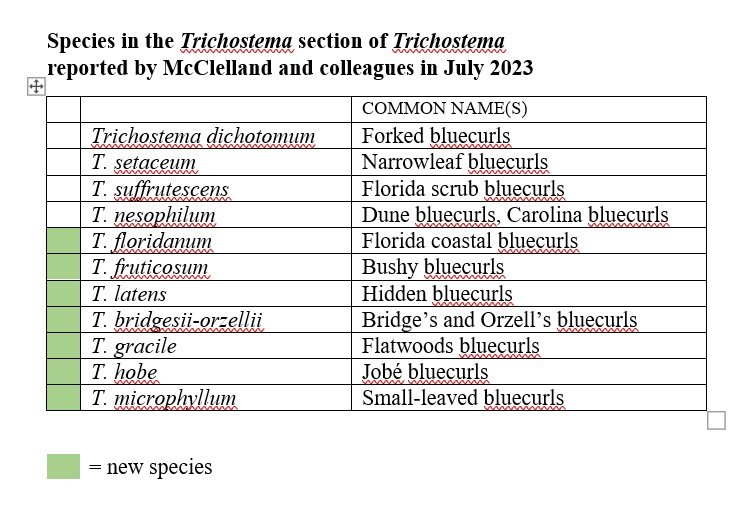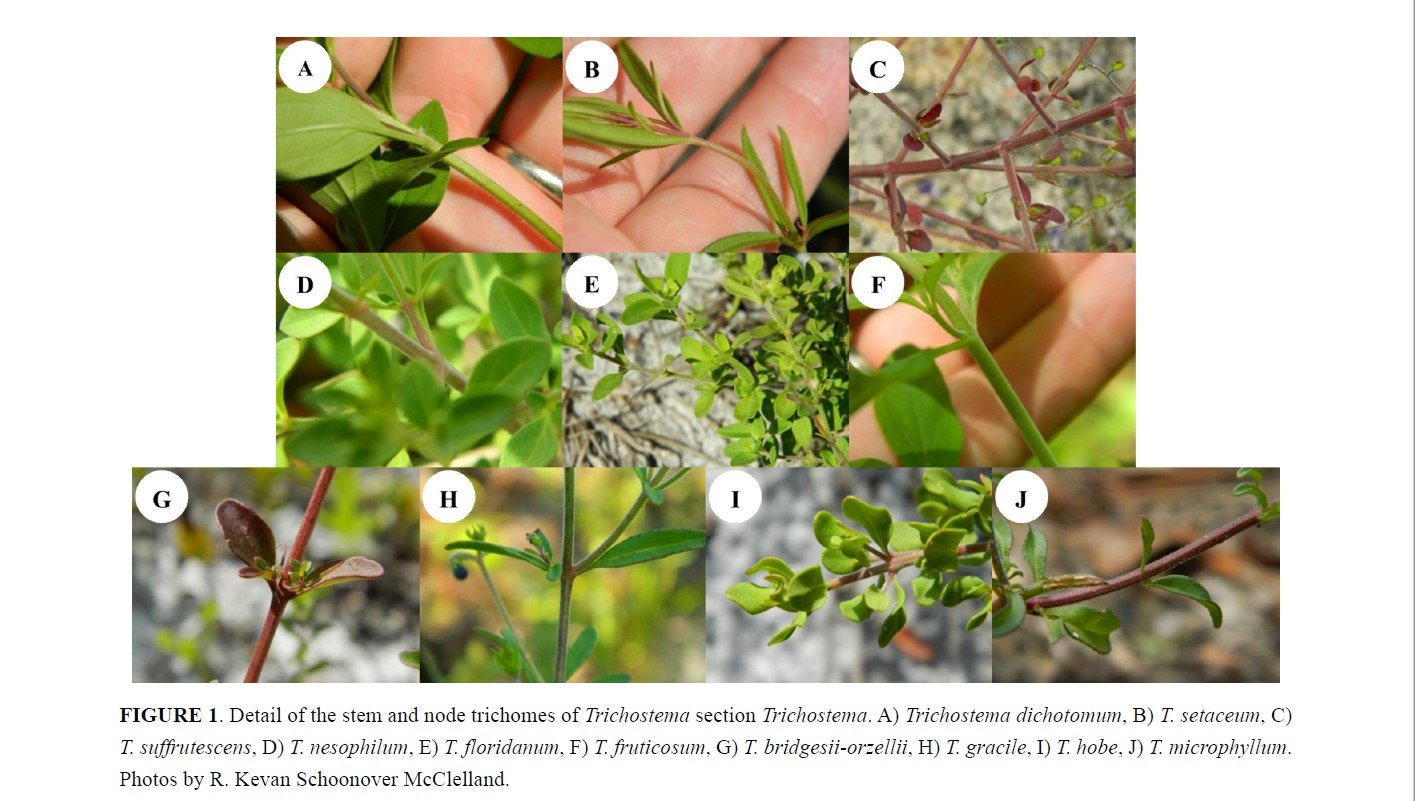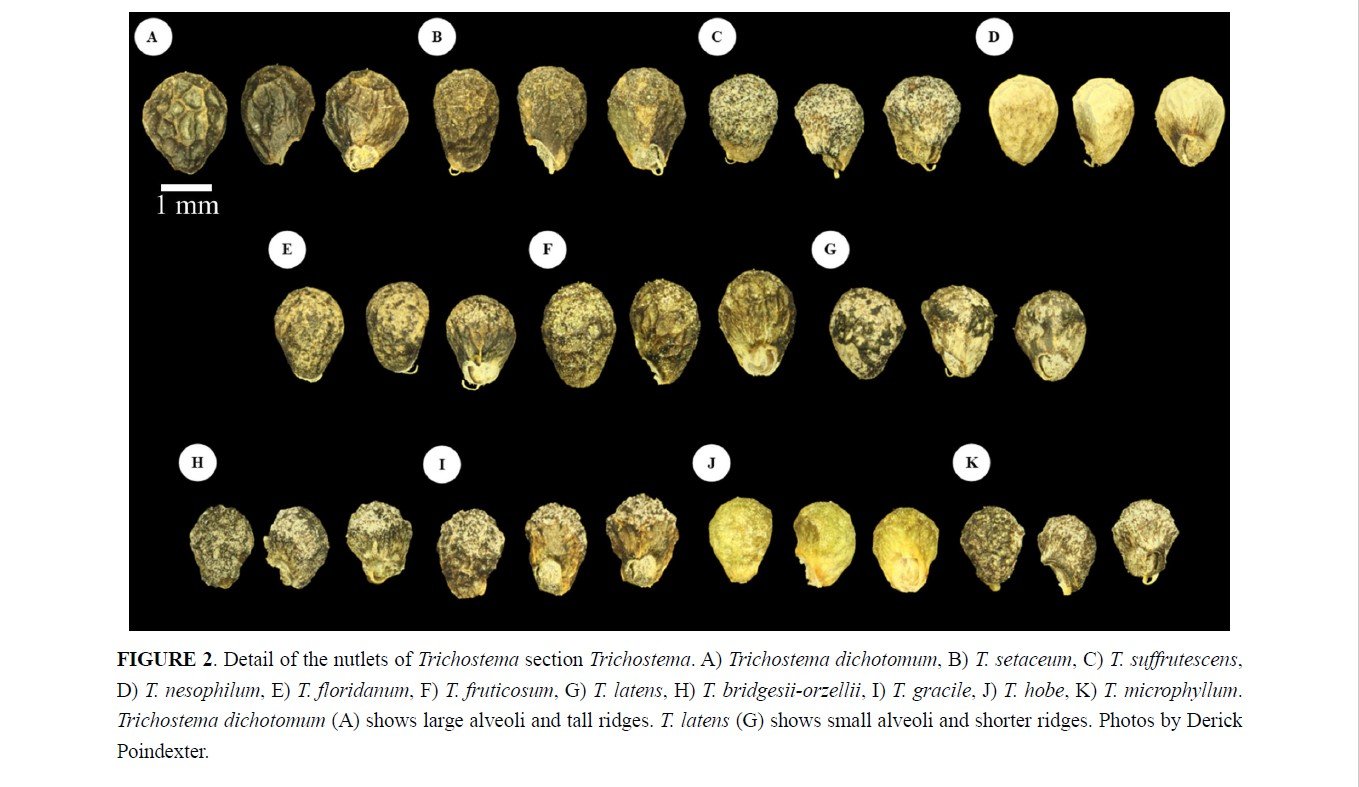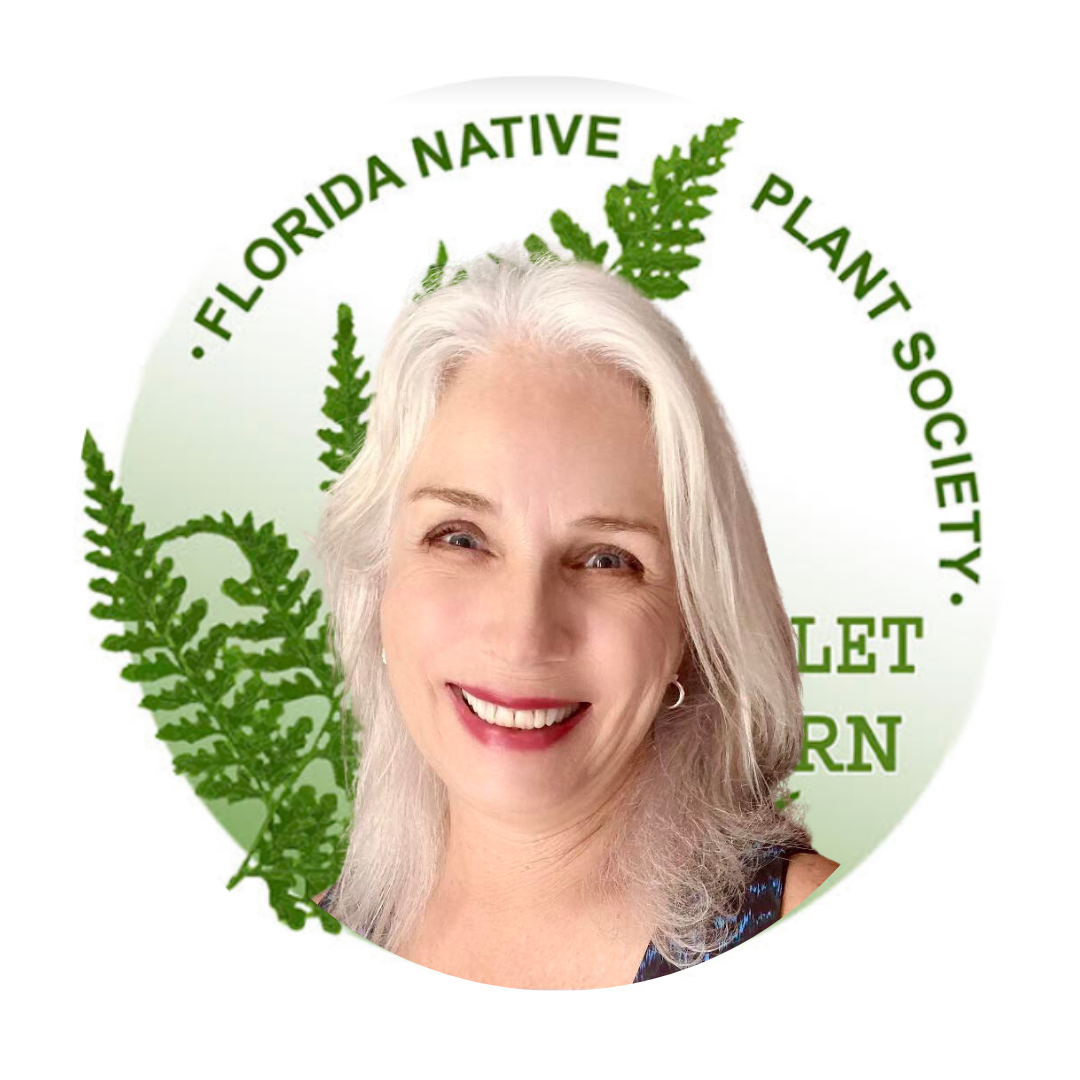Bluecurls Rescued, Vouchered by Cuplet Fern Amid New Species News
Karen Guin
A bluecurls plant that grew from seeds from the rescue site in Seminole County. (Photo by Chelsea LeNoble)
The plants known as bluecurls were growing on a small plot of undeveloped land in Seminole County slated for new-home construction.
A team from the Cuplet Fern Chapter of the Florida Native Plant Society visited the site and identified the plants as members of Trichostema — the scientific name for both a genus and section of flowering plants native to Florida and much of the eastern United States.
Cuplet Fern had gained approval to conduct its first native plant rescue at the site. The team members recognized the importance of rescuing the bluecurls, and they photographed the plants; documented their location and habitat; and moved them into pots, noting the date, time and weather as part of the rescue mission.
The team, comprising chapter leaders Chelsea LeNoble, Cali Adams, Jennifer Hopton-Villalobos and Mark Kateli, also recognized an opportunity. By carefully preserving some of the plants, Cuplet Fern could do something never done before: Submit the first voucher specimens of Trichostema in Seminole County to herbarium collections.
Kristen Marshall-Mattson demonstrates how to arrange a bluecurls sample for flattening and drying (Photo by Diane Vey)
Preparing the Specimens
An herbarium is a library of plant samples preserved for use in research and education. Most samples are flattened, dried and attached to a special type of herbarium paper.
A sample is considered a “voucher specimen” if it documents a plant’s diagnostic characteristics and is carefully collected and preserved following a process defined by the herbarium.
“Voucher specimens require many steps to become official, including permitting, establishing an official contact, pressing and mounting the specimen,” Hopton-Villalobos said. “It’s likely the primary reason Seminole County hadn’t been vouchered for Trichostema species before.”
LeNoble spearheaded the vouchering effort with support from Adams, Hopton-Villalobos and Kateli. She is a faculty member in industrial and organizational psychology at the University of Central Florida in Orlando who contributes her research expertise to Cuplet Fern as a volunteer.
To learn about plant vouchering, LeNoble consulted with local experts including Tina McIntyre, an agent at the Seminole County Extension of the University of Florida/Institute of Food and Agricultural Sciences in Sanford; Elizabeth Harris, director of the UCF Herbarium; and Kristen Marshall-Mattson, director of the Gillespie Museum at Stetson University in Deland.
Chelsea LeNoble (left) watches Kristen Marshall-Mattson demonstrate how to tighten the plant press (Photo by Diane Vey)
In October 2022, LeNoble uprooted the rescued bluecurls from their pots to use as Trichostema samples. She arranged each sample on a sheet of blotting paper, put another sheet of blotting paper on top of the sample, and added sheets of newspaper and cardboard to the bottom and top of the stack. She tightened the stack between the wood panels of a plant press on loan from the Gillespie Museum. The samples remained in the press until this summer.
In June LeNoble submitted one of the samples, along with the collection data and a detailed description of the “rosemary scrub” plant community from which the bluecurls originated, to the University of Florida Herbarium in Gainesville. Collections Manager Alan Franck formally accepted the sample as a voucher specimen of Trichostema that month.
LeNoble also has submitted a specimen to the University of South Florida Herbarium in Tampa and another to the UCF Herbarium.
“It’s the first time Cuplet Fern has submitted specimens to these herbaria,” said Kateli, president of both the Cuplet Fern Chapter and the Florida Native Plant Society.
Identifying the Species
The Cuplet Fern team was confident the bluecurls it rescued were members of the Trichostema section of the Trichostema genus. However, the team faced a challenge when trying to identify the plants at the species level.
“We compared them to the more common Trichostema dichotomum and Trichostema setaceum, but they did not match those descriptions,” LeNoble said. That’s when the group turned to the online Atlas of Florida Plants, maintained by USF, for species information and found there were no Trichostema species vouchered in Seminole County.
As it turns out, Cuplet Fern’s study of Trichostema species coincided with a period of upheaval in the world of Trichostema taxonomy. Just last month a scientific paper by doctoral student Kevan McClelland and colleagues at the University of North Carolina, Chapel Hill, identified seven new species within the Trichostema section of Trichostema. [1]
The species identified in the Trichostema section of Trichostema [1]
“Bluecurls in Florida were once lumped together under the species name T. dichotomum,” said McClelland in a 2021 virtual presentation to members of the Florida Native Plant Society. [2] Research by McClelland and his colleagues on structural, ecological, geographic range and genetic differences within the species led them to split T. dichotomum into T. dichotomum s.s. (or sensu stricto), meaning T. dichotomum in the strictest sense, and seven new Trichostema species.
Not surprisingly, McClelland follows and identifies observations of bluecurls on iNaturalist, an application and database used by citizen scientists, and he has identified observations posted by Cuplet Fern members.
“Kevan first identified the photo of our Trichostema voucher specimen on iNaturalist as T. suffrutescens, or Florida scrub bluecurls,” LeNoble said. However, he recently changed his identification to T. gracile, one of the seven new species reported in July. T. gracile’s common name is flatwoods bluecurls.
The following excerpt from the UNC researchers’ July paper on the difference between T. gracile and T. suffrutescens reflects their meticulous study of the morphology, or structure, of Trichostema specimens:
[T. gracile] differs from T. suffrutescens by branching regularly in the middle to upper part of the plant (vs. primarily near the base), its narrower leaves of 0.26–0.56 cm (vs. 1.13–1.74 cm), larger leaf length/width ratio of 3.87–7.08 (vs. 2.39–3.05), an ecological preference for mesic to scrubby flatwoods (vs. and ecological preference for scrub and scrub-sandhill ecotones), and a geographic restriction to xeric habitats off the main central ridge systems of Florida (vs. a geographic restriction to the main central ridge systems).
Figures 1 and 2 above from the July 2023 paper in Phytotaxa by Kevan McClelland and colleagues
Classification Transition, and a Spot
The Cuplet Fern team looks forward to learning the classification of its newly submitted voucher specimens of Trichostema in Seminole County by the Florida university herbaria. Will it be T. suffrutescens or T. gracile?
“My perspective is that USF will log [our Trichostema voucher specimen] as T. suffrutescens until their management group decides to adopt the new classification,” Kateli said. “It’s an operationally laborious process for each specimen. I expect the change in species classification to be visible to the public in a few years.”
In the meantime, the Cuplet Fern team is pleased its voucher specimens are now part of the herbarium collections. The next step is for USF to add a record of one the voucher specimens to its Atlas of Florida Plants, which displays maps of vouchered “wild” plants by county.
“Seminole County has been a big white spot on the map full of counties across the state in which Trichostema were vouchered,” LeNoble said. “We can’t wait to see that spot filled in.”
[1] McClelland, R.K.S., Weakley, A.L, & Poindexter, D.B. 2023. Seven new species of Trichostema (Lamiaceae: Ajugoideae) from the North American Coastal Plain biodiversity hotspot. Phytotaxa, 603(2): 95-149. https://phytotaxa.mapress.com/pt/article/view/phytotaxa.603.2.1
[2] The Bluecurls of Florida with Kevan McClelland (2021). https://www.youtube.com/watch?v=sNLCgDXiY-8
By Karen Guin
Learn more
Atlas of Florida Plants: https://florida.plantatlas.usf.edu
Herbaria and Herbarium Specimens: https://www.floridamuseum.ufl.edu/herbarium/methods/herbaria
UF Herbarium: https://www.floridamuseum.ufl.edu/herbarium
USF Herbarium: https://www.usf.edu/arts-sciences/departments/molecular-biosciences/research/herbarium.aspx
UCF Herbarium: https://sciences.ucf.edu/biology/facilities/herbarium







